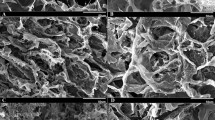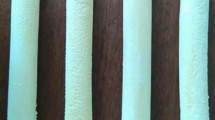Abstract
In this study, an attempt was made to develop bi-functional constructs serving both as scaffolds and potential delivery systems for application in neural tissue engineering. The constructs were prepared in two steps. In the first step, the bulks of poly (L-lactic acid) (PLLA) in 1, 4-dioxane/water (87:13) were fabricated using liquid-liquid thermally induced phase separation technique. In the next step, the prepared bulks were coated with chitosan nanoparticles produced by two different techniques of ultrasonication and ionic gelation by grafting-coating technique. In ultrasonication technique, the chitosan solution (2 mg/mL) in acetic acid/sodium acetate buffer (90:10) was irradiated by an ultrasound generator at 20 kHz and power output of 750 W for 100 s. In ionic gelation technique, the tripolyphosphate in water solution (1 mg/mL) was added to the same chitosan solution. The physicochemical properties of the products were characterized by Scanning Electron Microscopy, Attenuated Total Reflection Fourier Transform-Infrared, liquid displacement technique, contact angle measurement, compressive and tensile tests, as well as zeta potential and particle size analysis using dynamic light scattering. Moreover, the cell proliferation and attachment on the scaffolds were evaluated through human glioblastoma cell line (U-87 MG) and human neuroblastoma cell line [BE (2)-C] culture respectively. The results showed that the samples coated with chitosan nanoparticles prepared by ultrasonication possessed enhanced hydrophilicity, biodegradation and cytocompatibility compared with pure PLLA and PLLA coated with chitosan nanoparticles prepared by ionic gelation. This study suggests successful nanoparticles-scaffold systems which can act simultaneously as potential delivery systems and tissue engineering scaffolds.
Similar content being viewed by others
References
Schmidt CE, Leach JB. Neural tissue engineering:strategies for repair and regeneration. Annu Rev Biomed Eng 2003;5:293–347.
Kessler MW, Grande DA. Tissue engineering and cartilage. Organogenesis 2008;4:28–32.
Duarte ARC, Mano JF, Reis RL, Preparation of starch-based scaffolds for tissue engineering by supercritical immersion precipitation. J Supercrit Fluids 2009;49:279–285.
Zhu N, Li MG, Cooper D, Chen XB. Development of novel hybrid poly(L-lactide)/chitosan scaffolds using the rapid freeze prototyping technique. Biofabrication 2011;3:034105.
Tessmar JK, Göpferich AM. Matrices and scaffolds for protein delivery in tissue engineering. Adv Drug Deliv Rev 2007;59:274–291.
Blasi P, Giovagnoli S, Schoubben A, Ricci M, Rossi C. Solid lipid nanoparticles for targeted brain drug delivery. Adv Drug Deliv Rev 2007;59:454–477.
Kumari A, Yadav SK, Yadav SC. Biodegradable polymeric nanoparticles based drug delivery systems. Colloids Surf B Biointerfaces 2010;75:1–18.
Liu Z, Jiao Y, Wang Y, Zhou C, Zhang Z. Polysaccharides-based nanoparticles as drug delivery systems. Adv Drug Deliv Rev 2008;60:1650–1662.
Hejazi R, Amiji M. Chitosan-based gastrointestinal delivery systems. J Control Release 2003;89:151–165.
Muzzarelli RAA. Chitins and chitosans for the repair of wounded skin, nerve, cartilage and bone. Carbohydrate Polym 2009;76:167–182.
Shi C, Zhu Y, Ran X, Wang M, Su Y, Cheng T. Therapeutic potential of chitosan and its derivatives in regenerative medicine. J Surg Res 2006;133:185–192.
Freier T, Koh HS, Kazazian K, Shoichet MS. Controlling cell adhesion and degradation of chitosan films by N-acetylation. Biomaterials 2005;26:5872–5878.
Tang ES, Huang M, Lim LY. Ultrasonication of chitosan and chitosan nanoparticles. Int J Pharm 2003;265:103–114.
Patel JK, Jivani NP. Chitosan based nanoparticles in drug delivery. Int J Pharm Sci Nanotechnol 2009;2:517–522.
Suslick KS, Price GJ. Applications of ultrasound to materials chemistry. Annu Rev Mater Sci 1999;29:295–326.
Chen RH, Chang JR, Shyur JS. Effects of ultrasonic conditions and storage in acidic solutions on changes in molecular weight and polydispersity of treated chitosan. Carbohydrate Res 1997;299:287–294.
Gan Q, Wang T. Chitosan nanoparticle as protein delivery carrier—systematic examination of fabrication conditions for efficient loading and release. Colloids Surf B Biointerfaces 2007;59:24–34.
Gan Q, Wang T, Cochrane C, McCarron P. Modulation of surface charge, particle size and morphological properties of chitosan-TPP nanoparticles intended for gene delivery. Colloids Surf B Biointerfaces 2005;44:65–73.
Ko JA, Park HJ, Hwang SJ, Park JB, Lee JS. Preparation and characterization of chitosan microparticles intended for controlled drug delivery. Int J Pharm 2002;249:165–174.
Mi FL, Shyu SS, Chen CT, Lai JY. Adsorption of indomethacin onto chemically modified chitosan beads. Polymer 2002;43:757–765.
Hua FJ, Kim GE, Lee JD, Son YK, Lee DS. Macroporous poly(L-lactide) scaffold 1. Preparation of a macroporous scaffold by liquid—liquid phase separation of a PLLA—dioxane—water system. J Biomed Mater Res 2002;63:161–167.
Ho ST, Hutmacher DW. A comparison of micro CT with other techniques used in the characterization of scaffolds. Biomaterials 2006;27:1362–1376.
Salehi M, Nosar MN, Amani A, Azami M, Tavakol S, Ghanbari H. Preparation of pure PLLA, pure chitosan, and PLLA/chitosan blend porous tissue engineering scaffolds by thermally induced phase separation method and evaluation of the corresponding mechanical and biological properties. Int J Polym Mater Polym Biomater 2015;64:675–682.
Lao L, Tan H, Wang Y, Gao C. Chitosan modified poly(L-lactide) microspheres as cell microcarriers for cartilage tissue engineering. Colloids Surf B Biointerfaces 2008;66:218–225.
Hong Y, Gao C, Xie Y, Gong Y, Shen J. Collagen-coated polylactide microspheres as chondrocyte microcarriers. Biomaterials 2005;26:6305–6313.
Liao YZ, Xin MH, Li MC, Su S. Preparation and characterization O-lauroyl chitosan/poly(l-lactic acid) blend membranes by solution-casting approach. Chin Chem Lett 2007;18:213–216.
Chen C, Dong L, Cheung MK. Preparation and characterization of biodegradable poly(l-lactide)/chitosan blends. Eur Polym J 2005;41:958–966.
Moffa M, Polini A, Sciancalepore AG, Persano L, Mele E, Passione LG, et al. Microvascular endothelial cell spreading and proliferation on nanofibrous scaffolds by polymer blends with enhanced wettability. Soft Matter 2013;9:5529–5539.
Peniche C, Argüelles-Monal W, Davidenko N, Sastre R, Gallardo A, San Román J. Self-curing membranes of chitosan/PAA IPNs obtained by radical polymerization:preparation, characterization and interpolymer complexation. Biomaterials 1999;20:1869–1878.
Xu Y, Du Y. Effect of molecular structure of chitosan on protein delivery properties of chitosan nanoparticles. Int J Pharm 2003;250:215–226.
Wu Y, Yang W, Wang C, Hu J, Fu S. Chitosan nanoparticles as a novel delivery system for ammonium glycyrrhizinate. Int J Pharm 2005;295:235–245.
Yang F, Murugan R, Ramakrishna S, Wang X, Ma YX, Wang S. Fabrication of nano-structured porous PLLA scaffold intended for nerve tissue engineering. Biomaterials 2004;25:1891–1900.
Zhu X, Cui W, Li X, Jin Y. Electrospun fibrous mats with high porosity as potential scaffolds for skin tissue engineering. Biomacromolecules 2008;9:1795–1801.
Thanou M, Verhoef JC, Junginger HE. Oral drug absorption enhancement by chitosan and its derivatives. Adv Drug Deliv Rev 2001;52:117–126.
Pukanszk B, Maurer FHJ, Boode JW. Impact testing of polypropylene blends and comosites. Polym Eng Sci 1995;35:1962–1971.
Correlo VM, Boesel LF, Bhattacharya M, Mano JF, Neves NM, Reis RL. Properties of melt processed chitosan and aliphatic polyester blends. Mater Sci Eng A 2005;403:57–68.
Jiao Y, Liu Z, Zhou C. Fabrication and characterization of PLLA-chitosan hybrid scaffolds with improved cell compatibility. J Biomed Mater Res A 2007;80:820–825.
Li Z, Ramay HR, Hauch KD, Xiao D, Zhang M. Chitosan-alginate hybrid scaffolds for bone tissue engineering. Biomaterials 2005;26:3919–3928.
Zhang Y, Zhang M. Synthesis and characterization of macroporous chitosan/calcium phosphate composite scaffolds for tissue engineering. J Biomed Mater Res 2001;55:304–312.
Ma PX, Choi JW. Biodegradable polymer scaffolds with well-defined interconnected spherical pore network. Tissue Eng 2001;7:23–33.
Peña J, Corrales T, Izquierdo-Barba I, Doadrio AL, Vallet-Regí M. Long term degradation of poly (e-caprolactone) films in biologically related fluids. Polym Degrad Stab 2006;91:1424–1432.
Li RK, Weisel RD. Cardiac regeneration and repair. 1st ed. Cambridge, UK: Woodhead Publishing;2014.
Nasti A, Zaki NM, de Leonardis P, Ungphaiboon S, Sansongsak P, Rimoli MG, et al. Chitosan/TPP and chitosan/TPP-hyaluronic acid nanoparticles:systematic optimisation of the preparative process and preliminary biological evaluation. Pharm Res 2009;26:1918–1930.
Mi FL, Shyu SS, Lee ST, Wong TB. Kinetic study of chitosan-tripolyphosphate complex reaction and acid-resistive properties of the chitosan-tripolyphosphate gel beads prepared by in-liquid curing method. J Polym Sci B Polym Phys 1999;37:1551–1564.
Middleton JC, Tipton AJ. Synthetic biodegradable polymers as orthopedic devices. Biomaterials 2000;21:2335–2346.
Lu L, Peter SJ, Lyman MD, Lai HL, Leite SM, Tamada JA, et al. In vitro degradation of porous poly(L-lactic acid) foams. Biomaterials 2000;21:1595–1605.
López-León T, Carvalho EL, Seijo B, Ortega-Vinuesa JL, Bastos-González D. Physicochemical characterization of chitosan nanoparticles:electrokinetic and stability behavior. J Colloid Interface Sci 2005;283:344–351.
Chen S, Hao Y, Cui W. Biodegradable electrospun PLLA/chitosan membrane as guided tissue regeneration membrane for treating periodontitis. J Mater Sci 2013;48:6567–6577.
Lee JH, Park TG, Park HS, Lee DS, Lee YK, Yoon SC, et al. Thermal and mechanical characteristics of poly(l-lactic acid) nanocomposite scaffold. Biomaterials 2003;24:2773–2778.
Wan Y, Wu H, Cao X, Dalai S. Compressive mechanical properties and biodegradability of porous poly (caprolactone)/chitosan scaffolds. Polym Degrad Stab 2008;93:1736–1741.
Wang X, Song G, Lou T, Peng W. Fabrication of nano-fibrous PLLA scaffold reinforced with chitosan fibers. J Biomater Sci Polym Ed 2009;20:1995–2002.
Author information
Authors and Affiliations
Corresponding author
Rights and permissions
About this article
Cite this article
Salehi, M., Naseri-Nosar, M., Azami, M. et al. Comparative study of poly(L-lactic acid) scaffolds coated with chitosan nanoparticles prepared via ultrasonication and ionic gelation techniques. Tissue Eng Regen Med 13, 498–506 (2016). https://doi.org/10.1007/s13770-016-9083-4
Received:
Revised:
Accepted:
Published:
Issue Date:
DOI: https://doi.org/10.1007/s13770-016-9083-4




